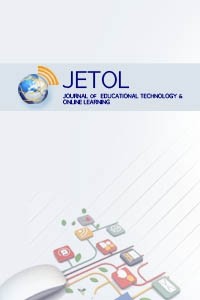Technology supported teaching implementations designed to improve critical thinking skills
Critical Thinking, GeoGebra, Preservice Mathematics Teachers
Technology supported teaching implementations designed to improve critical thinking skills
Critical Thinking, GeoGebra, Preservice Mathematics Teachers,
___
- Akbey, B. (2007). Eleştirel Düşünmenin Öğretiminde Öğretmenin Rolü. Bilim, Eğitim ve Düşünce Dergisi, Cilt 7, Sayı 2.
- Aytaçlı, B., (2012). Durum Çalışmasına Ayrıntılı Bir Bakış. Adnan Menderes Üniversitesi Eğitim Fakültesi Eğitim Bilimleri Dergisi, Haziran 2012, 3 (1), 1-9.
- Baki, A. (2001). Bilişim teknolojisi ışığı altında matematik eğitiminin değerlendirilmesi. Milli Eğitim Dergisi, 149, 26-31.
- Basri, H. & As’ari A.,R. (2018). Improving the critical thinking ability of students to solve mathematical task. JIPM (Jurnal Ilmiah Pendidikan Matematika) 7(1), 13-21.
- Budiman, H. (2013). Problem-based learning approach using dynamic geometry software to enhance mathematics critical and creative thinking abilities. https://researchgate.net/
- Büyüköztürk, Ş., Kılıç Çakmak, E., Akgün, Ö. E., Karadeniz, Ş., & Demirel, F. (2019). Bilimsel araştirma yöntemleri (26.Baskı). Pegem Akademi.
- Borazan, A. (2019). 11. sınıf dönüşümler konusunun öğretiminde dinamik geometri yazılımlarının öğretmen ve öğrenci merkezli kullanımının öğrencilerin akademik başarılarına ve motivasyonlarına etkisi (Yayın No. 545312) [Doktora tezi, İnönü Üniversitesi ]. YÖK. https://tez.yok.gov.tr
- Creswell, J. W. (2012). Planning, Conducting, and Evaluating Quantitative and Qualitative Research.(Fifth Edition).
- Çatalbaş, G. & Sarıtaş, E. (2022). Beceri Temelli Bir Düşünme Programı Uygulamasının Sınıf Öğretmeni Adaylarının Eleştirel Düşünme Becerileri ve Eğilimlerine Etkisi. Pamukkale Üniversitesi Eğitim Fakültesi Dergisi, 54, 328-356.
- Çepni, S. (2012). Araştırma ve proje çalışmalarına giriş (6.baskı). Yazarın kendisi.
- Çörekçioğlu, M. S. (2019). Matematik Öğretmenlerinin Ve Öğrencilerin Geogebra Yazılımının Kullanılması Hakkındaki Görüşlerinin İncelenmesi (Yayın No. 583893) [Yüksek lisans tezi, Atatürk Üniversitesi]. YÖK. https://tez.yok.gov.tr
- Doğan Dolapçıoğlu, S. (2015). Matematik dersinde otantik öğrenme yoluyla eleştirel düşünme becerisinin geliştirilmesi: Bir eylem araştırması (Yayın No. 417576) [Doktora tezi, Çukurova Üniversitesi]. YÖK. https://tez.yok.gov.tr
- Eğmir, E. (2018). Eleştirel Düşünme Becerisi Öğretimi: Ortaokul öğrencileri için bir program tasarısı. Pegem Akademi.
- Eğmir, E. (2016). Eleştirel Düşünme Becerisi Öğretim Programının Hazırlanması, Uygulanması Ve Değerlendirilmesi (Yayın No. 447711) [Doktora tezi, Afyon Kocatepe Üniversitesi]. YÖK. https://tez.yok.gov.tr
- Facione, P. A. (1990). Critical thinking: A statement of expert consensus for purposes of Educational assesment and instruction-executive summary-The Delphi Report.
- www. researchgate.net sayfasından erişilmiştir.
- Falcade R. (2001). L'environnement Cabri-géomètre outil de médiation sémiotique pour la notion de graphe d'une fonction. Unpublished manuscript, Mémoire de.
- Glazer, E. (2001). Using ınternet primary sources to teach critical thinking skills in mathematics. Greenwood press.
- Güven, B. & Karataş İ. (2003). Dinamik geometri yazılımı Cabri ile geometri öğrenme: Öğrenci görüşleri. The Turkish Online Journal of Educational Technology, 2(2), 67-78.
- Halpern, D. F.. (2014). Thought and Knowledge: An Introduction to Critical Thinking. ISBN: 978-1-84872-628-4
- İnce, H. (2012). Kırsal bölgelerde ve şehir merkezindeki öğrencilerin dönüşüm geometrisi anlama düzeylerinin ve uzamsal görselleştirme yeteneklerinin incelenmesi (Yayın No. 323480) [Yüksek lisans tezi, Eskişehir Osmangazi Üniversitesi]. YÖK. https://tez.yok.gov.tr
- Karadem, Z.,G.,Ongun, M., Taş, S. (2023). Developing Higher Level Thinking Skills in Teaching
- Mathematics from the Perspective of Mathematics Teachers. International Journal of Educational Studies in Mathematics, 10(1), 89 – 117.
- Korkmaz, Ö. (2008). Öğretmenlerin Eleştirel Düşünme Eğilim ve Düzeyleri. Ahi Evran Üniversitesi
- Kırşehir Eğitim Fakültesi Dergisi (KEFAD), Cilt 10, Sayı 1, 1-13.
- Kökdemir, D. (2012). Üniversite eğitimi ve eleştirel düşünme. Pivolka, 21, 16-19.
- Kurnaz, A. (2013). Eleştirel düşünme öğretimi etkinlikleri (2.baskı). Eğitim Yayınevi.
- Maričić,S., Špijunović, K. & Lazić, B. (2015). The Influence of Content on the Development of Students’ Critical Thinking in the Initial Teaching of Mathematics. Croatian Journal of Education Vol.18, 11-40. doi: 10.15516/cje.v18i1.1325
- Milli Eğitim Bakanlığı (MEB). (2017). Öğretmen Strateji Belgesi. http://oygm.meb.gov.tr/www/ogretmen-strateji-belgesi/icerik/406. Erişim tarihi: 25.04.2020.
- Milli Eğitim Bakanlığı (MEB). (2018). Ortaöğretim Matematik Dersi Öğretim Programı. http://mufredat.meb.gov.tr/Dosyalar/201821102727101-OGM%20MATEMAT%C4%B0K%20PRG%2020.01.2018.pdf . Erişim tarihi: 24.04.2020.
- Obay, M. (2009). Problem Çözme Yoluyla Eleştirel Düşünme Becerilerinin Gelişim Sürecinin İncelenmesi (Yayın No. 278295) [Doktora tezi, Gazi Üniversitesi]. YÖK. https://tez.yok.gov.tr
- Paul, R. (2007). www.criticalthinking.org/article/index
- Paul, R. & Elder, L. (2013). Kritik düşünce (Çev. Esra Aslan& Gamze Sart). Nobel Yayınları.
- Peter, E., E. (2012). Critical thinking: Essence for teaching mathematics and mathematics problem solving skills. African Journal of Mathematics and Computer Science Research Vol. 5(3), 39-43.
- Rasiman, (2015). Leveling of crıtıcal thınkıng abılıtıes of students of mathematıcs educatıon ın mathematıcal problem solvıng. Journal on Mathematics Education 6(1), 40-52. doi: 10.22342/jme.6.1.1941.40-52.
- Sezer, R., (2008). Integration Of Critical Thinking Skills Into Elementary Schoolteacher Education Courses In Mathematics. Education Vol. 128 No. 3.
- Semerci, Ç., (2003). Eleştirel Düşünme Becerilerinin Geliştirilmesi. Eğilim ve Bilim, Cilt 28, Sayı 127, 64-70.
- Suh, J., M. (2010). Leveraging cognitive technology tools to expand opportunities for critical thinking on data analysis and probability in elementary classrooms. Jl. of Computers in Mathematics and Science Teaching 29(3), 289-302.
- Yıldırım, A. & Simsek, H. (2008). Sosyal bilimlerde nitel araştirma yöntemleri (7.baskı). Seçkin Yayıncılık.
- Yüksel, N., S., Sarı Uzun, M. & Dost, Ş. (2013). Matematik öğretmen adaylarının eleştirel düşünme eğilimleri. Hacettepe Üniversitesi Eğitim Fakültesi Dergisi (H. U. Journal of Education) Özel Sayı (1), 393-403.
- ISSN: 2618-6586
- Yayın Aralığı: Yılda 3 Sayı
- Başlangıç: 2017
- Yayıncı: Gürhan DURAK
Teachers’ experiences and perspectives in conducting synchronous classes: Affordances and challenges
Jose Ramelle JAVIER, Simin LU, Ralkee MIJARES, Daisy QUIMPO, Jasthyne Cates SALAZAR, Jose Nıño SALES, Maricar PRUDENTE, Socorro AGUJA
Impacts of online education during COVID-19 on teaching English in rural state schools in Türkiye
Technology supported teaching implementations designed to improve critical thinking skills
Serkan GÜRSAN, Menekşe Seden TAPAN BROUTIN, Jale İPEK
Examining sense of community in the pandemic: A case of an online course
